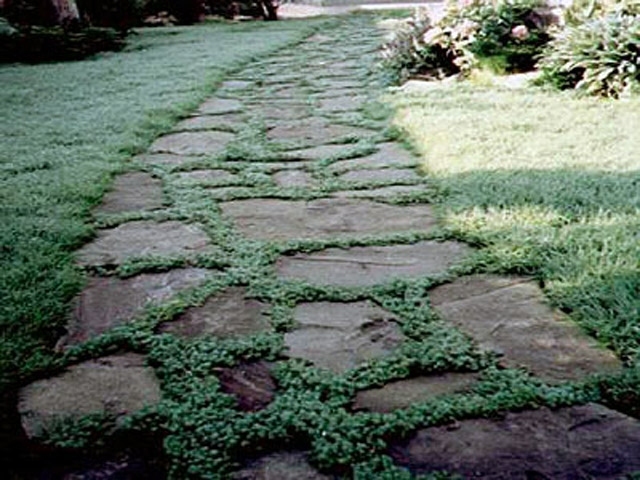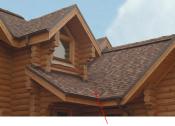Search
Login
How to build a stone walkway on a personal plot with your own hands
Today there are a lot of materials from which you can pave the paths on the infield. Of course, the leaders in the list of materials are natural stones. Paths made of chipped or tiled stones have excellent characteristics, but like in everything else, these materials also have disadvantages. The largest of them is a rather high price. But such a cost is justified by a long service life, a large percentage of strength and high decorativeness.
Content
- Natural stones for paths in the country, their advantages video
- Wild stone paths are the most popular varieties of natural material. video
- DIY stone tracks
- Stone Laying Options
- Some useful stone walkway tips video
- Laying tracks using geotextiles
- How to make a stone path
Natural stones for paths in the country, their advantages

Basically, tracks of this kind are made to approach the house. But if there is a desire and money, they can be placed in the garden, and in the clearing and in any zone intended for recreation. The look of natural stones will look good and combine with green grassy lawns, flowering colorful flower beds, alpine slides and other objects of floral and vegetable constructions. In this area, natural stones are unlikely to have standing rivals. Natural material has its own unique natural beauty and originality, ease.

In addition, the material has the highest strength characteristics. Knowing such characteristics, one can safely use various types of stone to equip paths: limestone, granite, shell rock, sandstone, paving stones and many others. But experts advise to remember that materials such as limestone and limestone, when used in the open air, lose their performance, and their service life becomes very short. These materials are very susceptible to climatic conditions.

Despite all the characteristics concerning only the material and its properties, a visual comparison will show the aesthetic difference between the path made of natural stone and its concrete likeness.
Wild stone paths are the most popular varieties of natural material.

The construction of paths made of natural stone will require considerable financial costs, therefore, the result is expected to be attractive in appearance, strength and reliability, a long period of operation. When choosing the type of material you need to know its quality and decorative characteristics. In most cases, for the construction of paths use:
- chipped paving stones, which is a granite or shungtite fragments of almost regular rectangular shape, with characteristic chipped edges, tile laying is quick and does not cause any special difficulties;
- flagstone, unlike paving stones, each fragment of it has different sizes and shapes, which gives the constructed walkways a special decorative effect;
- sawn stone before it reaches the buyer it is sawed and ground, which gives the stone a rectangular shape and a relatively smooth front surface;
- boulders, cobblestone- these stones differ practically only in size, boulders are larger, cobblestones are smaller, they have a rounded shape, different shades, this allows you to create very bright and original compositions and real panels.
DIY stone tracks

In order to properly make a path from natural stone, first of all, you need to designate it to the contours. Its parameters, forms and floridity will completely depend on the needs, desires and needs of the owner of the personal plot. Contour floridity can be described in different ways: moisten with a hose for irrigation, sprinkle with flour, mark with an ordinary rope. Then dig a trench. Its depth should be at least as a bayonet of a shovel.

The sod that has been dug up does not need to be thrown away. In the process, it can be used. After the trench is dug up, pebble should be put into it, walked, rubble or a brick fight. This layer is intended for drainage. It must be densified without fail. The next layer of wet sand also requires compaction.
Stone Laying Options

Subsequent actions can be performed in two ways. In the first - natural stones are laid on sand. It will be cheaper, physical and time costs will also be less. Now the stones must be pressed into a layer of sand. This can be done with a rubber mallet, that is, a mallet. Having laid a few meters in this way, the stone needs to be fixed. To fix, you need a sand-cement mortar, mixed 3: 1. With the help of a cone, which can be built from a cement bag, it is necessary to fill with a solution all the gaps formed between the stones.

The second method involves laying a stone on a concrete mortar. This process looks as follows. The mixed concrete mortar is poured up to 15 cm thick around the entire perimeter of the dug trench. In this embodiment, natural stones also need to be pressed with a mallet. After the cement coalesces with the stone laid in it, you can begin to close the gaps between the stones. This is also done using a cone, all from the same cement bag.
Some useful stone walkway tips
At first glance, laying out paths made of natural stone is very simple. But these options have their own particular nuances, the failure of which threatens with an unsuccessful result of work, wasted time and wasted money. The most important point is that the garden paths made of stone, after all work is completed, should be slightly above ground level. This moment allows the water not to linger, but to drain. This fact is important - such processes will help the design to be more durable and reliable.

To prevent the spread of stones, a curb needs to be built around the edges. Such borders made of natural stone can be purchased at any specialized store. It is also worth remembering that some natural materials become slippery at low temperatures. For example, marble refers to such - it is not suitable for paving garden paths.
Laying tracks using geotextiles

After geosynthetic material appeared on the modern construction market, the ability to build a stone path with your own hands without using cement became very real. To create such a path you will need a trench. Its width will completely depend on the desire of the owner of the plot. Its depth can vary from 25 cm to 35 cm. The bottom of the dug trench must be thoroughly cleaned of roots, stones and other debris. Then the bottom is well tamped. After that, crushed stone should be poured into the trench and lay non-woven geotextiles. Lay the canvas in such a way that its edges are outside the trench and so that their length outside is at least 40-50 cm. The next layer will be of gravel, which also requires compaction. Next, taking the edges of the canvas, you need to cover with a lap a layer of rammed gravel. It will be a drainage.

On top of the geotextile it is necessary to pour a layer of wet sand, approximately 15 cm thick. Now you can put pavers or stone tiles on the sand. Each individual stone element laid must be gently pressed into the sand with a rubber mallet. The gaps formed after indentation are filled with sand using an ordinary broom. This process is not fleeting. It can last about two weeks, until all the gaps are thoroughly filled with sand. If shrinkage of one or several elements of the masonry is found, it will be enough to lift the seated fragment, add sand to the vacant place, put the fragment in place and press it with the same rubber hammer.
How to make a stone path
Before you make a garden path on your personal plot, you need to familiarize yourself and carefully study the existing methods of paving. The most interesting and unusual design option for a garden path is the technology of laying from single stones. This technology is simple and does not require the installation of complex formwork. By analogy with other ways of arranging the track, and in this, too, first of all, you need to determine the location. Its most optimal width will be up to 60 cm. Tracks of this plan are intended for walking, and not for running. For an approximate determination of the width of your step, you need to go some distance, measure it and divide it by the number of steps taken. You also need to remember to add here 5 cm to the possible gaps between the stones.

When the dimensions of the path and the place of its future location are precisely determined, at this particular place there is a need to remove the top layer of soil and draw a trench. At its bottom, you need to make a bed of sand with a layer of about 10 cm. A layer of this thickness will be enough for a fairly long time of operation of the path. When there is a desire to get a feeling of hewn stone, the edges of the path should be made uneven. How exactly the next step will be taken, there is not much difference. It is possible to prepare the soil separately for each stone, or you can dig a ditch and after casting, fill the gaps between the stones with earth with grass seeds.
When a similar track is not planned to be used often, it will be more economical to build it on one cobblestone. Otherwise, when its location on the site involves intensive use, it makes sense to dig a continuous ditch. Each individual stone must be fenced with a specially made formwork. To create the formwork, bulky planks that coincide in width with the width of the trench are quite suitable. At a certain stage of work, the formed gaps are filled with soil. To prepare the fill, you need to take 5 parts of sand, 1 part of cement, 1 part of water. The resulting concrete mix can easily withstand a pressure of 25 kg per 1 sq. Km. see. For the garden path on the plot this will be enough. When preparing a solution, it is very important to ensure that its viscosity resembles sour cream. Experts advise, in the process of pouring stones, to press iron rods or pieces of reinforcement into the concrete mass. These iron supplements must be taken care of in advance.

Before starting pouring, the ditch must be watered. This action will make it possible to compact the sand, prevent the shrinkage of stones and prevent the flow of concrete composition into the ground. When casting, it is necessary to ensure that the stones used are at the same level. Fulfilling this condition, a correctly executed design is formed. When you are standing on it and standing with two legs on different stones, there will be no discomfort or height difference. Of course, it is not necessary to build a path only horizontal. Stone elements can be decorated in the form of steps.

When such paving of natural stones is made, the possibility of decorating concrete will solve the issue of combining concrete and natural stone. In order for this to happen, you need to level the concrete surface, and then make protrusions and dents on it. The trowel is very useful in this process. the height transition can be about 1 cm. On the next day, when the concrete mortar began to set, but is still quite loose, if desired, you can make small grooves in it and fill them with a cement composition of a different color.
This finish is best used on large stones or on a solid path. With medium sizes, bumps will be too visible. The described installation will be finished the next day, when the stones will be given roundness. This is done by neatly chucking the edges. This will prevent chipped edges. After the work, the owner of the site for a long time will enjoy the appearance, originality and originality of his work.





